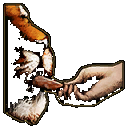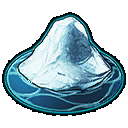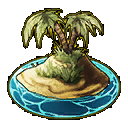Overview
To breed tamed animals you have to have male and female of the same species. Both of the breeding pair need to be set to wandering and need to be in close proximity. You need the right skill for breeding animals. Tier 1 requires Breeding. Tier 2 need Breeding Tier 2. And the last one tier 3 with Breeding Tier 3
Temperature is important when breeding. The mating will not start or will be interrupted if the temperature is not correct for that species. When both pairs are set to wandering and in close proximity, but the mating doesn't start the female may have icon over her head. Icon with an island with snow on top means it's too cold to start mating, tropical island with palm trees suggest that it's too hot.
Temperature is also important after an egg is laid or when the mother has given birth in order to hatch the egg and grow the animal into maturity; the baby will lose health if the temperature is not suitable. Babies can't eat by themselves (ex: from a ![]() Feeding Trough), they need to have edible food (for that species) in their inventory or they will starve to death. The inventory weight, stomach and health of the baby will be limited in function of its maturity; it requires a lot of care in its early days.
Feeding Trough), they need to have edible food (for that species) in their inventory or they will starve to death. The inventory weight, stomach and health of the baby will be limited in function of its maturity; it requires a lot of care in its early days.
Breeding is a feature of ATLAS that allows players to breed improved creatures through eggs with non-mammals and gestation with mammals. Eggs do not have an owner, so it's possible to steal eggs laid by other survivors' animals.
Newborn creatures are simply claimed (imprinted on) and do not require the usual taming processes associated with wild creatures. Anyone can claim a newborn. This must be done promptly, along with feeding it, as babies can die quickly from hunger.
Breeding Mechanics
Preparing Mating
The first step of breeding is having two opposite sex creatures of the same species for mating. Most creatures can be bred; those few that cannot are listed at the bottom of this article. See Sterile Creatures for more information.
Mating Requirements
For creatures to successfully mate, both sexes must be:
- within mating range of each other
- wandering or set to mate(Enable Wandering must be enabled on both creatures)
- not following anything (Disable Following on both creatures)
- unburdened (the creatures must not be carrying so much weight they are unable to move)
Mating Range
The mating range varies between species and is loosely based on the size of the adult creature. Building a pen of a suitably small size to keep the wandering animals within mating range of each other is one common approach.
If you do not want to build a pen, you can use the "Whistle Stop (All)" command (u on PC). This halts all tamed animals within the area to stop moving if you have the appropriate command skill, even ones that are enabled to wander. It's best to use the whistle every time the creature starts to move again, or to prevent the animals from ever-moving, whistle constantly. While this method doesn't need a pen, it does need you or a company member to stay there and constantly whistle. This may be more helpful if one survivor is constantly whistling not to move, and another survivor enables the creatures nearby to wander and mate. In this way, you can achieve mass breeding in an area without ever building a pen, or moving creatures.
To initiate breeding of a pair by yourself, whistle both creatures to follow you, then enable wandering or mating. Then, disable following on both. This prevents them from walking around in the meantime.
Mating
When the above conditions are all met, a beating heart icon appears over the heads of the mating creatures, and a mating bar appears on the female's HUD (look at the female to reveal the HUD). The HUD also indicates which creature they are mating with. Ensure the mating animals remain close together, as otherwise the mating stops. Due to server lag and game mechanics, the mating bar does not continuously update in real time. Additionally, mating multiple females to a single male at the same time can make this worse. Patience is advised as the bar moves in leaps and bounds.
Once the mating bar is completed, non-mammalian females drop a single fertilized egg, and mammalian females start gestating.
Animals require a specific biome and temperature to mate. These numbers can be found on the animals pages.
Mating Wait Interval
Females cannot mate again until a mating wait interval has passed. This interval is indicated on their HUD. For mammals, the mating wait interval does not commence until after their gestation has completed.
Males can mate again immediately.
Incubation
- Main article: Incubation
The fertilized egg itself only begins Incubation when dropped into the world, not in Inventory. When dropped, a Fertilized Egg must be kept at a certain temperature range depending on the species (this also factors in insulation). If outside of this temperature range, incubation won't make progress, and it loses "Fertilized Egg Health" over time and is destroyed if this reaches zero. This is all indicated on the HUD when looking at a Fertilized Egg, along with its Parents.
Managing Temperature
The best method to ensure eggs are at an appropriate temperature for incubation is through insulation.
Use a heat source to regulate the egg's temperature. ![]() Torch,
Torch, ![]() Campfire work well. However, they all have the downside of providing negative Heat Tolerance, making careful management necessary. You may need four or more torches, depending on the biome and the egg.
Campfire work well. However, they all have the downside of providing negative Heat Tolerance, making careful management necessary. You may need four or more torches, depending on the biome and the egg.
Since temperature gradients can be very extreme between regions it is very possible to have temperatures to high or low constantly when only relaying on the weather. Early in the game, it is easier to find a biome that is colder and heat the egg with torches, rather than trying to cool down in a hot biome.
As Fertilized Eggs don't lose Egg Health in an inventory, and spoil incredibly slowly, you can keep them in your Inventory or in a preserving bag or food larder until able to achieve the appropriate temperature needed for Incubating. This can be very useful if you settled in a region with extreme temperatures as it's especially difficult to cool an egg in a hot biome without an air conditioner when it gets too hot.
mammals also need tempurature regulation while in the maturarion state. heat can be achieved via the ![]() Torch,
Torch, ![]() Campfire method but cooling is another story, best method is to sail the baby on a boat to the edge of to climates that match the animals needs. if its to hot in one move to the next and vice versa this will achieve perfect tempeature all the time
Campfire method but cooling is another story, best method is to sail the baby on a boat to the edge of to climates that match the animals needs. if its to hot in one move to the next and vice versa this will achieve perfect tempeature all the time
Gestating
During gestation, females can consume up to twice the amount of food they would normally. Ensure the expectant mother has access to plenty of food during gestation to avoid losing the baby. NEEDS VERIFIED
Claiming
Babies are born unclaimed, so a survivor must "claim" them immediately after birth by getting close to them, looking right at them, and pressing the "use" key e to imprint them, otherwise they can be claimed by other survivors.
If babies are not very promptly claimed and then fed they can quickly die from hunger.
Caring For Babies

Feed the Baby
Young animals take significant time and intensive care, especially during the "Baby" stage. Some animals on stock server settings will require several days to complete, others could be several hours. You can keep fertilized eggs in a ![]() Preserving Bag or
Preserving Bag or ![]() Food Larder, but beware they will eventually spoil. Mammals will gestate and then drop a live animal, once mating is complete there is no stopping or pausing the arrival of the baby.
Food Larder, but beware they will eventually spoil. Mammals will gestate and then drop a live animal, once mating is complete there is no stopping or pausing the arrival of the baby.
New babies are set to wandering and can be claimed by ANY person, who ever claims the baby will be imprinted on that baby. New babies have extremely low health, carrying capacity and food, so players need to hand feed them in their first moments of life, or they'll soon die. The creature must be fed by adding food to their inventory. Once they reach 10% of their maturation they will enter the Juvenile phase allowing them to eat from a ![]() Feeding Trough. The maturation progress is shown when looking at the creature.
Feeding Trough. The maturation progress is shown when looking at the creature.
At 50% the animal will enter the final phase Adolescent.
Babies dynamically gain more HP, food capacity, and carrying capacity as they mature over time. While an animals are maturing they will eat a piece of food when they have enough room for that food. Example. A berry provides 2 food. So when a baby has room for 2 food it will eat a berry . A ![]() Potato provides 60 food. Therefore, a baby only eating
Potato provides 60 food. Therefore, a baby only eating ![]() potato will eat less
potato will eat less ![]() potato than
potato than ![]() berries.
berries.
Babies are not mountable and flee from fights.
It takes a long time for babies to mature; breeding should only be attempted if you or your tribe have the time. Normally as the baby grows, you will be able to leave the baby alone for longer and longer periods of time, as of v18.9 babies will continue to eat from inventory/trough when out of rendering distance. If you will be imprinting, the baby will either want a cuddle or to go for a walk every so often the number will be displayed over the animals head.
Avoid the cold

Baby is freezing
An important step to maintaining breeding is preparing a space prior to starting the process. It is suggested for most animals that are capable of breeding to use a colder climate or have the baby on a ship and shift between 2 zones to avoid the heat, you can use ![]() Torch ,
Torch , ![]() Campfire or Penguin to heat them effectively
Campfire or Penguin to heat them effectively
One method is the use of campfires. They provide approximately 130 Hypothermia insulation. This method requires room to have several ![]() campfires placed. You would then light fires as needed to keep your animal from having the blue cold emblem.
campfires placed. You would then light fires as needed to keep your animal from having the blue cold emblem.
Another method is to use a system of torches bound to nearby levers to allow more precise control over the adjustment of the temperature without manually turning on or off individual torches. ![]() Torch heat provide approximately 40 hypothermia insulation and are cost-efficient in resources. A
Torch heat provide approximately 40 hypothermia insulation and are cost-efficient in resources. A ![]() torch will burn for 6 hours and 40 minutes real time before it's durability reaches 0, assuming the torch is not crafted from a blueprint.
torch will burn for 6 hours and 40 minutes real time before it's durability reaches 0, assuming the torch is not crafted from a blueprint.
You can also use the Penguin to mitigate the heat. They have an insulation (AoE) Buff. The AoE scales with the Creature level and will help with high temperatures. (Penguins AoE insulation does not currently work with babies.)
- v104.61 patch
Creature babies no longer require the desired temperature after they reach 10% maturity
Avoid the heat

Baby's too hot
As of now, it seems as if there arent much possibilities to remove the heat debuff on your baby.
Some people try to cool them down with water from the ![]() Bucket but it doesn't work very well.
Bucket but it doesn't work very well.
You are most likely better off taking your little one with you on your ship and move for the maturing process to a colder area.
But be carful of natural hazards like the storm, since it could potentially fly your baby off the ship or it may glitch into the boat's structure and get stuck/unreachable.
Sterile Creatures
All tameable creatures are breedable except for: Giant Crab, Cyclops, Drake, Fire Elemental, Gorgon
Times for Breeding
Breeding Tier 1
| This article is a work-in-progress. The content and format of this page may change drastically over the next few hours or days. |
| Tier | Creature | Possible yet | Food 1st state | Food 2nd state | Needed Temperature |
|---|---|---|---|---|---|
| 1 | Chicken | Yes | Fruits | ? | |
| 1 | Monkey | Yes | Berries | ? | |
| 1 | Parrot | Yes | Fruits |
? | |
| 1 | Rabbit | Yes | ? | ||
| 1 | Sheep | Yes | Medicinal Herb | ? |
Breeding Tier 2
| This article is a work-in-progress. The content and format of this page may change drastically over the next few hours or days. |
| Tier | Creature | Possible yet | Food 1st state | Food 2nd state | Needed Temperature |
|---|---|---|---|---|---|
| 2 | Bear | Yes | 7°C-14°C | ||
| 2 | Bull | Yes | |||
| 2 | Cow | Yes | --- | ||
| 2 | Crow | Yes | Vegetables / |
Egg 36°C - 45°C, Baby 14°C - 30°C | |
| 2 | Horse | Yes | Vegetables / Fruits / |
Vegetables / Fruits / |
- - - |
| 2 | Ostrich | Yes | --- | ||
| 2 | Pig | Yes | - - - | ||
| 2 | Seagull | Yes | |||
| 2 | Vulture | Yes | --- | ||
| 2 | Wolf | Yes | --- | ||
| 2 | Penguin | Yes | ? |
Breeding Tier 3
| This article is a work-in-progress. The content and format of this page may change drastically over the next few hours or days. |
| Tier | Creature | Possible yet | Food 1st state | Food 2nd state | Needed Temperature | Time to adult |
|---|---|---|---|---|---|---|
| 3 | Elephant | Yes | 27c - 45c | 72h | ||
| 3 | Giant Crab | No | ? | ? | - | - |
| 3 | Giant Tortugar | Yes | Chili | Chili | - | - |
| 3 | Giraffe | Yes | Vegetables / Fruits | - | - | |
| 3 | Lion | Yes | - | - | ||
| 3 | Rhino | Yes | - | - | ||
| 3 | Tiger | Yes | - | - | ||
| 3 | Razortooth | Yes | - | - | ||
| 3 | Shieldhorn | Yes | Vegetables | Vegetables | - | - |
Notes
Breeding Tier 3 is possible.
Taming
Imprinting
Patch History
| Patch | Notes |
|---|---|
| 18.90 | Fixed an issue with babies not eating from inventory/troughs when in stasis. |
| 18.84 | Baby creatures will no longer take into account the temperature alterations from coldfront and heatwave |
References
| |||||||||||||||||||||||||||||||||||||
fr:Reproduction it:Allevamento pl:pt-br:
